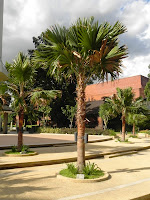About a month ago I discovered the poll option in my blog. I did not know before that you could actually create a section here where readers could vote on a certain topic. I was excited in choosing what would be the very first poll question I would air for blog followers and the topic was not at all hard to come up with.
Every time I do a lecture on trees I always start with species which I anticipate most of my listeners would be familiar with. Usually it would include acacia, mango, langka, santol, aratiles, macopa, duhat, atis, papaya, kaimito, chico etc., which are basically what we find growing in most Metro Manila households. All of them get a bit surprised that none of the mentioned are actually native to the Philippines. Most are either Central or South American species brought here in the Galleon trade routes. Some have also been prehistorically introduced by ancestral Filipinos when they rode their bancas (from mainland Asia, Indonesia or Polynesia) and settled on Philippine shores. These trees we find abundantly growing as echoes of what our ancestors have told us to grow in our households. In the case of the gallleon trade trees, they were subliminally forced upon us by the gobernadorcillos and prayles, telling indios what were productive to cultivate and domesticate. One example is the song bahay kubo where a lot of common vegetables were mentioned to be planted in our backyard, yet none of these are native. Because of it the Bicolano laing could never be complete without the sili (Capsicum, native to the Americas). Karekare and paella could never be as delectable and colorful without achuete (Bixa orellana, also from Americas) etc.
In the June poll, I listed six trees: acacia, santol, duhat, mango, narra and langka as choices for known native trees. It is good to hear that out of 35 respondents, 24(68%) considered narra as their top pick as native tree. They were right. The other choices were all exotic trees. Acacia (Samanea saman) is an American tree brought here at the end of the Spanish era. Santol (Sandoricum koetjape), langka (Artocarpus heterophylla) and duhat (Syzygium cuminii) are natives of neighboring countries which were brought into the Philippines by ancestral Filipinos. Mango is an Indian tree also introduced prehistorically but varieties not present in India were already developed and adapted to local growing conditions, hence we have our kalabao and piko varieties.
So the right answer is... Narra or Pterocarpus indicus! This Philippine native could also be seen in other neighboring countries. But in the Philippines it is prized because of the good grained and reddish-colored wood. It has other economic uses including medicinal properties. It is believed to cure high blood pressure. said by processing the tannins into a tea concoction. Indeed a wonder native tree.
A new poll is now posted below. Please cast you votes!
Every time I do a lecture on trees I always start with species which I anticipate most of my listeners would be familiar with. Usually it would include acacia, mango, langka, santol, aratiles, macopa, duhat, atis, papaya, kaimito, chico etc., which are basically what we find growing in most Metro Manila households. All of them get a bit surprised that none of the mentioned are actually native to the Philippines. Most are either Central or South American species brought here in the Galleon trade routes. Some have also been prehistorically introduced by ancestral Filipinos when they rode their bancas (from mainland Asia, Indonesia or Polynesia) and settled on Philippine shores. These trees we find abundantly growing as echoes of what our ancestors have told us to grow in our households. In the case of the gallleon trade trees, they were subliminally forced upon us by the gobernadorcillos and prayles, telling indios what were productive to cultivate and domesticate. One example is the song bahay kubo where a lot of common vegetables were mentioned to be planted in our backyard, yet none of these are native. Because of it the Bicolano laing could never be complete without the sili (Capsicum, native to the Americas). Karekare and paella could never be as delectable and colorful without achuete (Bixa orellana, also from Americas) etc.
In the June poll, I listed six trees: acacia, santol, duhat, mango, narra and langka as choices for known native trees. It is good to hear that out of 35 respondents, 24(68%) considered narra as their top pick as native tree. They were right. The other choices were all exotic trees. Acacia (Samanea saman) is an American tree brought here at the end of the Spanish era. Santol (Sandoricum koetjape), langka (Artocarpus heterophylla) and duhat (Syzygium cuminii) are natives of neighboring countries which were brought into the Philippines by ancestral Filipinos. Mango is an Indian tree also introduced prehistorically but varieties not present in India were already developed and adapted to local growing conditions, hence we have our kalabao and piko varieties.
So the right answer is... Narra or Pterocarpus indicus! This Philippine native could also be seen in other neighboring countries. But in the Philippines it is prized because of the good grained and reddish-colored wood. It has other economic uses including medicinal properties. It is believed to cure high blood pressure. said by processing the tannins into a tea concoction. Indeed a wonder native tree.
A new poll is now posted below. Please cast you votes!



















































